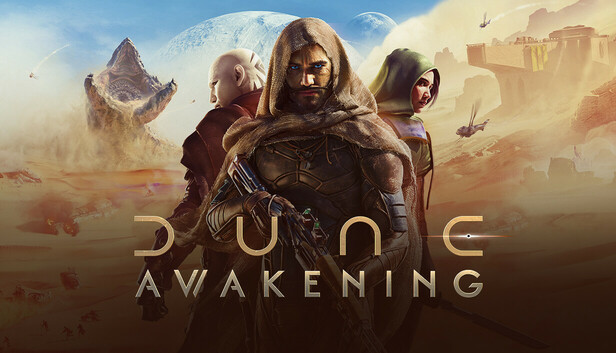- > Dune Awakening CHOAM Salvage Rights Event - Strategies, Rewards, Tips
- > Dune Awakening Erythrite Crystal Farming Guide
- > Dune Awakening All Mysa Tarill Unique Schematics and Locations
- > Dune Awakening Dupe Glitch: Another Duplication Found and Patched
- > Dune Awakening Arrakeen Guide - What to Do, Where to Go & Tips
- > Dune Awakening Solo Endgame Guide for Survivors of the Deep Desert
Dune Awakening First Impressions: Is It Worth Playing in 2025?
If you’re a fan of survival MMOs or the Dune universe, chances are Dune Awakening has been on your radar for a while. Set to release on June 10, 2025, with early access beginning June 5, the hype train has been rolling strong, especially with Funcom promising an open-world experience set on the unforgiving desert planet of Arrakis. As a veteran gamer who’s logged thousands of hours across MMOs and survival sandboxes alike, I had to dive in and see if this game lives up to the buzz. Spoiler alert: it’s a mixed bag, but there’s plenty to unpack here.
With the game launching soon (mark your calendars for June 10), Funcom gave the press early access to a sizeable portion of the map, the Hagga Basin. Unlike heavily scripted press demos, this was more of a raw experience, dropping us in to fend for ourselves—or so I thought. That alone had me excited. I went in expecting Rust or ARK levels of survival intensity, but what I found was something in between a themepark MMO and a survival game. It tries to wear both hats, and the results are... complicated.
For anyone considering where to get started, there are already tools and services out there like Dune Awakening Solari from PVPBank that aim to help new players get a leg up, especially in areas like currency farming. But before you invest any time or money, let’s break down what you’re really signing up for.
The Survival Elements: Hit or Miss?
Let’s start with the survival mechanics because, well, it’s Dune. Water is life, and in Dune Awakening, that’s no joke. From the moment you hit the ground, your thirst meter is a constant concern. The stillsuit mechanics are a fantastic touch—as you explore, the suit slowly rehydrates you, staying true to the lore. You can gather water from desert flora or extract it from fallen foes, but purification is required. It’s immersive and creates tension, at least early on.
But beyond thirst, the game’s survival challenge feels watered down (no pun intended). After the tutorial wraps up, resources come easy, and threats feel a bit toothless unless you deliberately seek out danger zones. Yes, sandworms are terrifying, but as long as you follow basic survival rules (like not running on deep sand for too long), you won’t feel like you’re truly battling the harshness of Arrakis.
MMORPG at Its Core
This is where Dune Awakening leans hard into MMO territory. You’re introduced to the game through a hefty questline led by a character named Zantara. It walks you through everything—gear crafting, shelter building, and combat basics. It’s thorough, but also feels like you’re stuck on rails for the first 10-15 hours. For survival purists, that can be a bit of a letdown.
Skills and crafting unlocks are tied not just to XP (called intel points here) but also to quest progression. This dual gatekeeping can be frustrating. You might have the points needed to unlock a new tool or weapon, but unless you’ve ticked off the right quest, you’re out of luck. It’s very reminiscent of the Star Wars Galaxies post-NGE days, where sandbox freedom gave way to more structured, linear progression. Some players will appreciate the guidance; others will find it stifling.
Combat and PvE: Surprisingly Fun
The combat system deserves some praise. There’s a clever interplay with the lore: basic enemies fall to knives and dart guns, while shielded foes require you to bait them into attacking first, then counter with a well-timed heavy strike. It rewards skill and timing rather than mindless button mashing, which kept fights interesting.
Bandits, ship patrols, and wild fauna offer a decent variety of PvE challenges, but like the survival mechanics, it all feels a bit safe. Once you’ve got your gear and understand the combat rhythm, most encounters become predictable. Still, there’s enough here to keep you engaged, especially when exploring new regions or stumbling across bandit camps.
Building and Progression
Housing and base-building are big features, but again, they feel more MMO than survival sandbox. Your first shelter is part of the main quest, and it’s a stepping stone rather than a true survival necessity. The building system is robust, and there’s plenty of room to get creative, but it’s clear that your home base is more about function than expressing your inner architect.
Progression is where the game stumbles a bit. Unlocks are chained behind multiple requirements, and there’s a constant push to move your base or rebuild elsewhere as quests dictate. It adds a layer of grind that feels more like busywork than meaningful progression at times.
Performance and Polish
Visually, Dune Awakening nails the Arrakis aesthetic. The dunes stretch endlessly, sandworms are genuinely terrifying, and little touches like desert blooms add authenticity. But performance is hit or miss. During my preview, there were noticeable hiccups: texture pop-ins, clunky melee animations, and occasional UI glitches. It’s nothing game-breaking, but it’s worth keeping in mind if you’re hoping for a flawless Day One experience.
Final Thoughts: Who Is This For?
So, is Dune Awakening worth playing in 2025? That depends. If you’re a die-hard Dune fan itching to explore Arrakis, there’s a lot here to love—from deep lore integration to solid PvE mechanics. If you’re looking for a pure survival game, though, you might feel shortchanged. The game leans heavily into MMO tropes, especially in the early hours, and that might turn off sandbox purists.
That said, Dune Awakening is still evolving. Funcom has shown they can turn rocky launches into success stories (Conan Exiles, anyone?). If they can tweak the balance between survival and MMO elements, this game could become something special. For now, I’d recommend keeping an eye on it, maybe even jumping in at launch if you’re curious—but temper your expectations.
Have you tried the beta or are you planning to? Drop your thoughts in the comments below. And if you’re planning to dive in, services like "Dune Awakening Solari" and "PVPBank" could give you that extra edge out of the gate.

